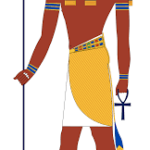
Thoth symbol
| Symbol | Thoth |
| Religion | Ancient Egyptian Religion |
| Origin | Thoth's origins trace back to ancient Egyptian mythology, where he emerged as a prominent deity during the Old Kingdom period. |
| Meaning | Thoth symbolizes wisdom, knowledge, writing, communication, balance, and magic in ancient Egyptian belief systems. He was revered as the inventor of writing and the patron of scribes. |
| Appearance | Depictions of Thoth often show him as a man with the head of an ibis or a baboon, reflecting his connection to these animals. He's sometimes depicted holding a writing palette or a scroll. |
| Colors | The colors associated with Thoth's symbols are often symbolic of wisdom, knowledge, and mystical attributes. These may include shades of blue, gold, and silver. |
| Usage | The symbol of Thoth is used in various contexts, including religious rituals, art, literature, and modern adaptations inspired by ancient Egyptian culture. |
| History | Thoth's worship dates back to ancient Egyptian civilization, where he held a prominent place among the pantheon of gods. His cult grew over time, and he remained an important figure throughout Egyptian history. |
| Popularity | Thoth's popularity endured throughout ancient Egyptian history, and his influence extended to other cultures through trade and cultural exchange. |
| Importance | Thoth was crucial in Egyptian mythology as the mediator between good and evil, order and chaos. His role as the inventor of writing and the patron of scribes elevated him to a position of great importance in Egyptian society. |
| Complexity | Thoth's symbolism is multifaceted, representing various aspects of wisdom, magic, and divine communication. His roles as a scribe, judge, and mediator add layers of complexity to his character. |
| Emotions | The symbol of Thoth evokes feelings of reverence, awe, respect for wisdom, and a sense of connection to ancient Egyptian spirituality and culture. It may also inspire feelings of mystery and fascination due to its historical significance and enigmatic imagery. |
While Thoth, the ancient Egyptian god of knowledge, writing, and magic, isn’t directly represented by a single symbol, his complex nature is often conveyed through various interconnected icons. Here’s a breakdown of the key ones:
1. Ibis and Baboon: Thoth is most commonly depicted with the head of an ibis, a long-beaked wading bird. The curved beak resembled the crescent moon, linking him to lunar cycles and their association with knowledge and writing. Sometimes, he appears as a baboon, another animal linked to wisdom and the written word.
2. Moon Crescent and Crown: The crescent moon itself is a symbol of Thoth, often adorning his head or appearing in his hand. It reinforces his connection to the moon and its perceived influence on knowledge and magic. Additionally, he might wear a special crown incorporating the moon crescent, signifying his divine status and intellectual power.
3. Scribal Tools: Objects like a palette and stylus represent Thoth’s role as the inventor of writing and record-keeping. These tools highlight his association with communication, education, and the preservation of knowledge.
4. Ankh: Thoth is frequently depicted holding the ankh, the ancient Egyptian symbol for life. This emphasizes his role as a giver of knowledge, which was seen as essential for achieving eternal life in the afterlife.
Remember: These symbols often appear together, forming a richer representation of Thoth’s multifaceted nature. Understanding their individual and combined meanings provides a deeper appreciation of this fascinating deity’s role in Egyptian mythology and its enduring influence on human imagination.